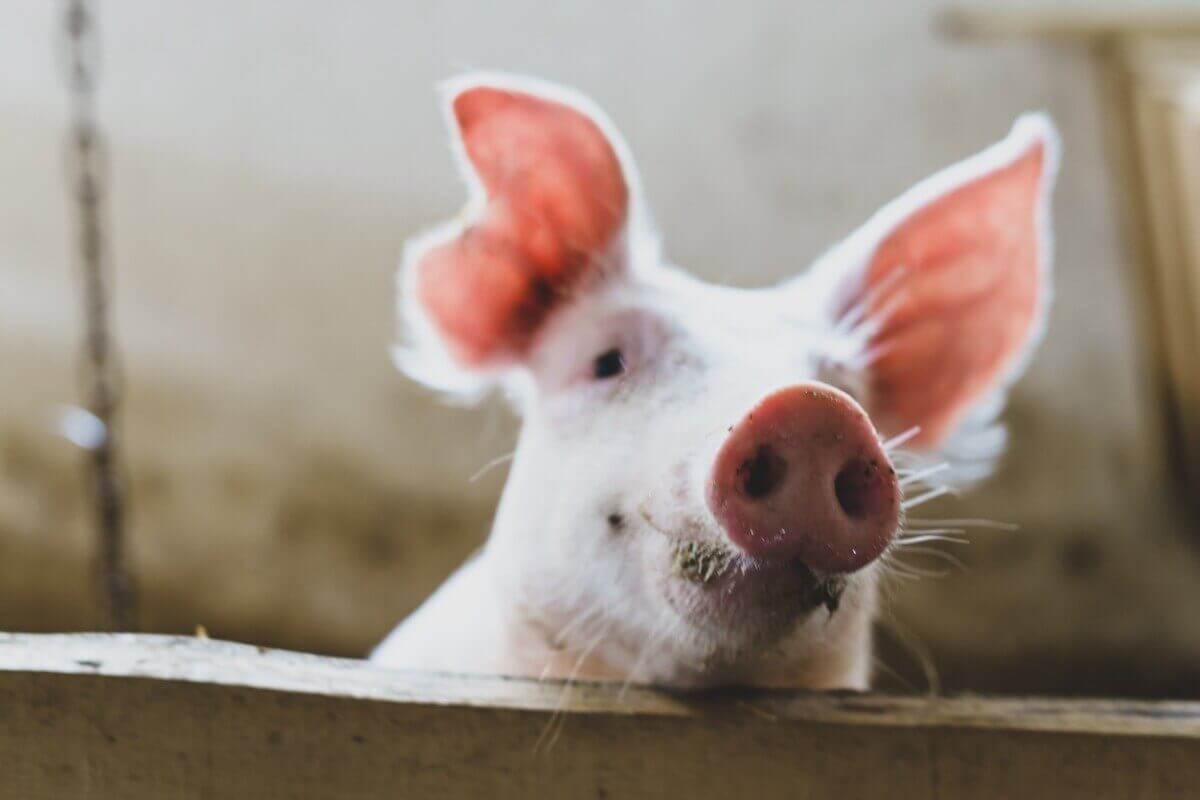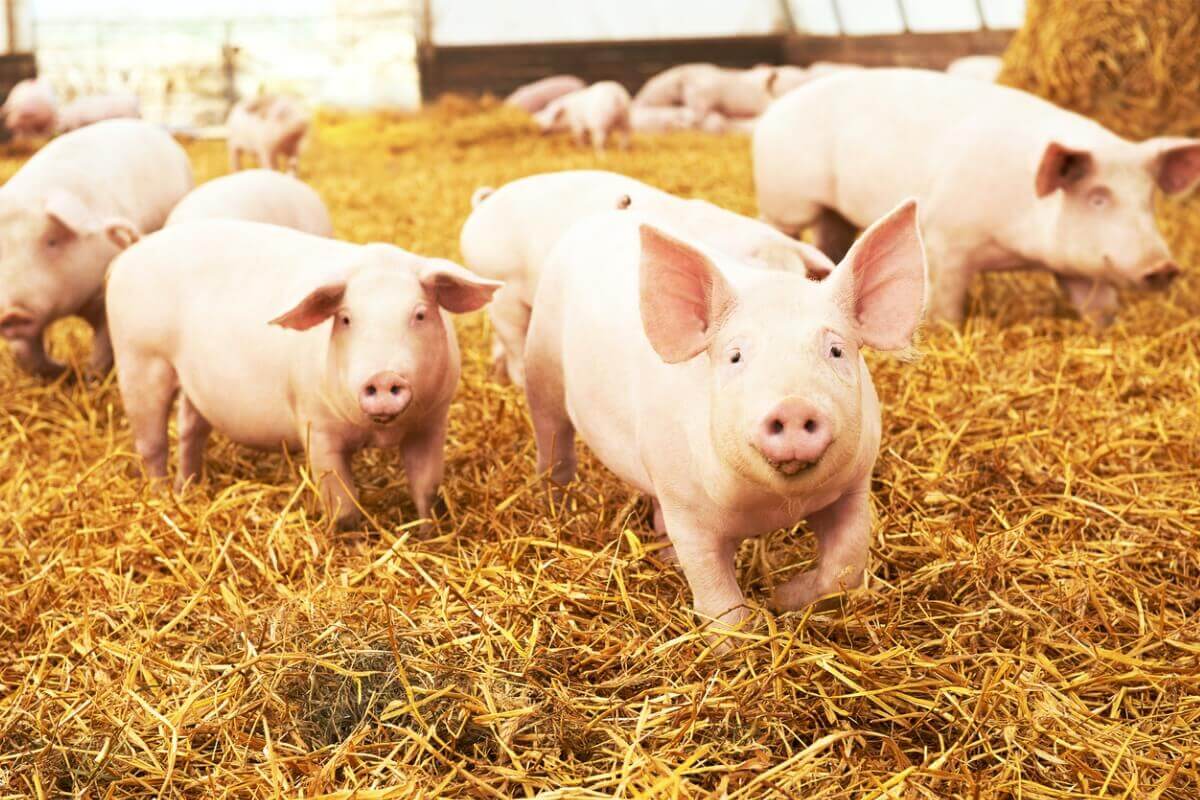Did You Know That Pigs Don't Sweat?

Around the animals considered “farm animals” orbit a series of sayings and beliefs that often don’t fit with reality, such as the phrase “sweat like a pig”. Today, we’re going to reveal a little know secret: The truth is, pigs don’t sweat.
In fact, in this article, we’ll disprove 2 popular beliefs about swine. Are you curious to learn more? Here, you’ll learn something more about pigs, which are incredible but underrated animals. Keep reading!
Do pigs sweat?
The answer is simple: no, pigs don’t sweat. To sweat, you need sweat glands that secrete water and mineral salts through the dermis. This substance (sweat) evaporates with the ambient heat, thus lowering the skin temperature.
However, pigs have very few sweat glands, so it’s impossible for them to sweat. In fact, these mammals are very sensitive to high temperatures precisely because of this reality, as their dissipation of body heat is more limited.
Because humans are so accustomed to this thermoregulation mechanism -in fact, we’re among the animals that sweat the most-, sometimes we don’t realize that it’s not very common among other species. Dogs, for example, only sweat through the pads of their feet. To dissipate excess heat, they help themselves by panting.

If pigs don’t sweat, then where does the saying “sweating like a pig” come from?
How did it occur to anyone to say that someone else “sweats like a pig” if they’ve never seen one sweat? Actually, the origin of this phrase is due to a misunderstanding of the origin of this common saying.
Centuries ago, in the United Kingdom, the word pig was used to refer to the molds into which cast iron was poured, as it was shaped like the breasts of these animals. The molten iron in the mold was called pig iron.
To know if the iron had solidified, blacksmiths needed to check if there was a layer of liquid on its surface, that is, the “pig’s sweat”. For this reason (and because of the high temperatures in the foundries), “sweating like a pig” became established as a catchphrase. Therefore, the actual meaning of the phrase has nothing to do with the sweating of an actual live pig.
How do pigs regulate their temperature?
So, this brings us to the next question. If pigs don’t sweat, then how do they not die of heat? And this is where the second myth about pigs comes in–the idea that they wallow in their own feces because they’re filthy.
Like other animals that don’t sweat, pigs choose to protect their skin from the sun by taking mud baths. Elephants, hippopotamuses, and other mammals also do this, as the earth creates a protective barrier that shields them from the sun.
The problem comes when you keep pigs in poor conditions: If they live surrounded by their own feces, they’ll have no choice but to wallow in it to protect themselves from the heat. This obviously makes them smell bad and develop skin problems, so it’s not a natural behavior for them.
In reality, swine are very clean animals; if you have the opportunity to see them living in optimal conditions, you’ll notice that they keep themselves clean and tidy.
How to help pigs thermoregulate
If you live with these cute animals, you know that too much sun exposure can cause them problems. Although they know how to regulate themselves through bathing, it’s important to prepare their space so that they don’t suffer from any of these imbalances:
- Heat stroke: Pigs go out of their optimal thermal zone at 26°C. Heat stroke can be as deadly as in any other species.
- Sunburn: Crossbred farm pigs have whiter skin and less hair than wild pigs, which makes them much more prone to sunburn. The burns are very painful for the animal.
- Squamous cell carcinoma: A sunburn can lead to this type of cancer, which is very common due to exposure to ultraviolet rays.
So what do you do to ensure the health of your pigs in this regard? Most of the information comes from the experience of sanctuaries that rescue pigs from farms. Over many years, they’ve sought the best care for them, which allows us to give you this general advice:
- Your space should have shelter and plenty of shade so that your pig can take refuge from unfavorable weather conditions.
- Provide a pond: It’s as easy as digging a hole in the ground with a ramp on one side and just allow the rain to fall in. Pigs will really enjoy bathing and wallowing in the mud. However, the space should be kept as clean as possible to avoid infection and other ailments.
- Provide clean, cool water throughout the day: Drinking is also a way to lower body temperature.
- Use sunscreen: Using sunscreen specifically for pigs is a great help in preventing them from getting sunburned – they love to nap in the sun – as well as preventing skin cancer. The mixture should be spread over the ears, back, belly, and shoulders.

Pigs are one of the most punished animals in popular culture. Always seen as food or interchangeable goods, they’re rarely given an identity of their own despite being incredibly smart and loving animals. That’s why debunking the myths surrounding them is one more step towards recognizing their true nature and fostering empathy towards them.
All cited sources were thoroughly reviewed by our team to ensure their quality, reliability, currency, and validity. The bibliography of this article was considered reliable and of academic or scientific accuracy.
- The Open Sanctuary Project, Inc. (2021, 21 septiembre). Pigs and Mud: Let them Wallow! The Open Sanctuary Project. https://opensanctuary.org/article/pigs-and-mud/
- The Open Sanctuary Project, Inc. (2020, 4 agosto). The Importance Of Sun Protection For Pigs. The Open Sanctuary Project. https://opensanctuary.org/article/the-importance-of-sun-protection-for-pigs/
- Schifferli, C., González, H., & Yaciuk, R. (1995). Neoplasias en el cerdo. Descripción patológica de los casos diagnosticados durante 10 años. Arch. Med. Vet., 27.
This text is provided for informational purposes only and does not replace consultation with a professional. If in doubt, consult your specialist.